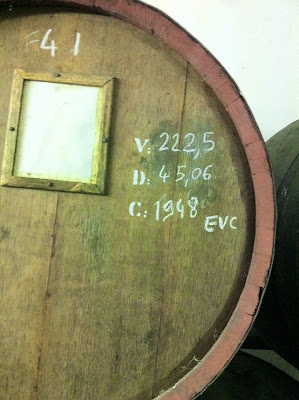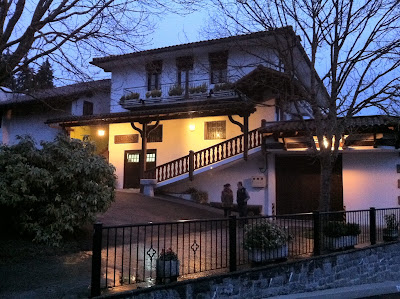What follows is not a proper photo essay because my journey through England, France, and the Basque Country took me to some eddies and side-tours not strictly focused on cider. But maybe that's a feature of this post and not a bug. I'll put most of them below the fold so they don't run forever down the page. They proceed in chronological order and although I took about the same number of photos of each place on my good camera these, on my phone's, seem to be unevenly distributed. Sorry, Normandie! Also, I tried not to repeat photos I used in earlier posts about
Herefordshire,
wild fermentation,
Normandy,
Txotx season, or
perry.
 |
The Grain Barge in Bristol had the best tap cider I found, but Ashton
Press, which I liked, is owned by Butcombe Brewery. |
|
 |
| Sometimes the hedgerows seemed menacing. |
 |
| Another shot of Tom Oliver's cellar in the old hop building. |
 |
Mike Johnson's orchard. Compare the size of these trees with the Basque
trees below. |
 |
Burrow Mump in Somerset. According to the interpretive material, both
words mean "hill." You can see the flooding if you look through the ruins
of the door. The entire county seemed to be under water. |
 |
The only place you can see cheddar cheese being made in the village of
Cheddar in Somerset. |
 |
Drouin has barrels of Calvados dating back to the war.
These family, which founded the distillery in 1960,
purchased these lots. |
 |
| The gorgeous coastal town of Honfleur in Normandy. |
 |
| The view of the Drouin distillery from the farmhouse. |
 |
The oak tree in Gernika where Basques have traditionally
met to formalize agreements. This is a descendant of
the original. It's a sacred symbol to the Basques. |
 |
A device used to pick apples up off the ground; called
a kizki in Euskera (Basque). |
 |
| So many sidras.... |
 |
The Basque Country was fascinating. It's incredibly wet there, and the
emerald hills look a lot like Oregon's. They now grow conifers as a crop,
enhancing the counterfeit. The villages are tiny and compact, built tall and
oddly urban, even when the population is less than 5,000. |
 |
| Tiny Basque apple trees. Some are bigger--but none more than about 8 feet. |
 |
Pinxtos, or Basque tapas, in Donostia (aka San Sebastian). This is one of
the rare places you don't find cider. Beer or wine is more common. (I saw
not a single decent beer when I was there.) |
 |
Donostia. It's sometimes called Donostia-San Sebastian, but on road signs,
the later name was often defaced. |
|
 |
These glasses were ubiquitous. Short and wide, made of incredibly thin,
elegant glass. You pour only two fingers from a great height to "break"
the cider--or rouse and aerate it. |
|
 |
| Isastegi Sagardotegia |
 |
The calendar at Isastegi. On the right is an activity; an apple means it
happens that month. Edan, for example, means "drinking." Every month! |
 |
| Typical Basque construction, reminiscent of the interior of Norman homes. |
 |
| Snow-capped mountains near Bilbao. |





















